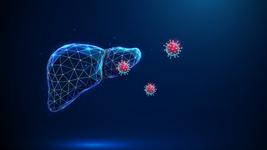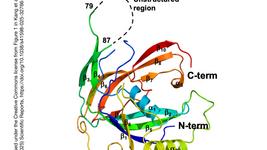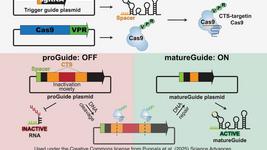CMN Weekly (17 October 2025) - Your Weekly CRISPR Medicine News
By: Gorm Palmgren - Oct. 17, 2025
Top picks
- Scientists have engineered "universal" regulatory T cells for off-the-shelf transplant therapy by using CRISPR to disrupt HLA class I and II genes while inserting an HLA-E fusion protein. In this way, they created hypo-immunogenic Tregs that evade both T and NK cell rejection. These engineered allogeneic Tregs maintained their immunosuppressive function and successfully prolonged human skin graft survival in humanized mice comparable to autologous cells. This multiplex HLA engineering approach offers a promising solution for creating ready-to-use Treg therapies that overcome the limitations of donor variability and manufacturing delays in urgent clinical situations.
- Researchers used prime editing technology to successfully install and correct a pathogenic PRPH2 gene mutation (c.828+1G>A) that causes inherited retinal diseases in human induced pluripotent stem cells. The mutation was found to activate aberrant splicing and create defective transcripts in retinal organoids, while prime editing correction restored normal PRPH2 expression without off-target effects. The study demonstrates prime editing's potential as a precise gene therapy approach for treating PRPH2-related inherited retinal diseases.
Research
- A cytosine base editor has been improved by relocating the uracil DNA glycosylase inhibitor (UGI) from the traditional C-terminal position to an internal fusion site within the nCas9 protein. This spatial reorganization maintained high on-target editing efficiency while significantly reducing Cas9-dependent off-target DNA effects, providing a new engineering approach for creating safer, high-fidelity base editors for genome editing applications.
- A Chinese study combined Mendelian randomization analysis with single-cell RNA sequencing in a rat facial nerve injury model to identify therapeutic targets for peripheral facial paralysis. Results indicated that SLIT2 and other proteins (SEMA4D, EFEMP1, SPRED2) are significantly associated with the condition. The researchers found that SLIT2 is highly expressed in microglia and inhibitory neurons after facial nerve injury, with enhanced SLIT2-ROBO signaling between neurons and glial cells, suggesting this pathway as a promising therapeutic target for promoting nerve repair and recovery.
- A new CRISPR-Cas13 system uses engineered crRNAs that target conserved regions of influenza A virus RNA, successfully reducing viral replication and inflammatory responses in human lung chip models. The treatment showed minimal off-target effects and worked against multiple flu strains, suggesting potential as a pan-influenza therapeutic. This study demonstrates how human organ-on-chip technology can provide more clinically relevant preclinical testing than traditional animal models for precision gene therapies.
- Researchers at MIT has presented DIAL, a modular framework that generates multiple stable expression levels from a single promoter through recombinase-mediated editing. Though not CRISPR-based and focused on transgene control rather than endogenous genes, the system addresses a core limitation of CRISPR knockout, CRISPRi, and CRISPRa studies – the inability to reveal phenotypes that depend on precise gene dosage rather than binary on/off states.
- Researchers have developed a barcoded AAV6 system to track individual gene-edited hematopoietic stem cell clones. They discovered that despite initial diversity, transplanted edited cells are dominated by few clones in mouse models. Using this tracking system, they optimized gene editing protocols for correcting PKLR mutations causing pyruvate kinase deficiency by implementing GMP-grade media, adding NHEJ inhibitors, and shortening transduction times.
Screening
- A new co-selection method enriches for cells with high base editing activity to overcome cell-to-cell variability that typically reduces the effectiveness of CRISPR base editing screens. By comparing this approach to traditional methods using TP53 as a model, the authors demonstrate improved ability to identify functionally important mutations and protein regions. This modular selection strategy enhances the resolution and reliability of base editing screens for functional genomics applications.
Delivery
- Delivery of Cas9 mRNA via lipoplex nanoparticles specifically targets trabecular meshwork cells and successfully edits the MYOC gene, American researchers show. The intervention rescued a mouse model of inherited glaucoma by reducing toxic protein accumulation and relieving ER stress. A single intracameral injection of this non-viral CRISPR system knocked out mutant MYOC, restored normal intraocular pressure, and showed good safety profiles. This approach offers a promising one-time therapeutic strategy for treating Primary Open Angle Glaucoma caused by MYOC mutations.
Clinical & preclinical
- CRISPR Therapeutics has presented preclinical data showing that its investigational therapy CTX460 can correct the SERPINA1 Z (E342K) mutation underlying alpha-1 antitrypsin deficiency (AATD). The treatment, which uses the company’s SyNTase gene-editing platform, achieved over 90 per cent mRNA correction and restored circulating protein more than five-fold in rodent disease models after a single dose.
- Cellectis has announced promising Phase 1 results for lasme-cel, an allogeneic CAR-T therapy targeting CD22 in heavily pretreated relapsed/refractory B-cell acute lymphoblastic leukemia patients. At the recommended Phase 2 dose, 42% achieved complete remission with 80% being MRD-negative, while a subset of younger patients (≤50 years) showed 56% complete remission rates and 100% overall response with 78% MRD-negative. Though not publicly disclosed, lasme-cel is most likely developed using TALEN-based gene editing.
- Shanghai BRL Medicin has achieved a world-first breakthrough by successfully treating a Neuromyelitis Optica Spectrum Disorder patient with allogeneic BCMA-targeted Universal CAR-T therapy, developed using CRISPR gene editing. The patient, who had suffered from this autoimmune demyelinating disease causing vision loss and neurological symptoms, experienced only mild fever during treatment and successfully cleared target cells. The patient was discharged after discontinuing all immunosuppressants, marking significant progress in using universal CAR-T technology for treating refractory autoimmune neurological diseases.
Industry
- Novo Nordisk is discontinuing its cell therapy research and development program, affecting approximately 250 employees, as part of broader restructuring efforts under new leadership. The Danish pharmaceutical giant was developing cell therapies for type 1 diabetes and Parkinson's disease but will now seek external partners for these innovations while focusing on core operations amid company-wide job cuts totaling 9,000 positions.
Detection
- A novel PCR-CRISPR-Cas12a platform incorporates strategically mismatched bases in crRNA to achieve highly sensitive detection of EGFR point mutations at the single-cell level. The platform demonstrates superior performance compared to conventional ARMS-PCR, detecting mutations at 0.1% frequency in just 1.02 ng of DNA with accuracy matching next-generation sequencing. Combined with conical-pore membrane technology for single circulating tumor cell enrichment, this approach enables precise mutation detection in individual cancer cells, offering enhanced capabilities for personalized cancer treatment and resistance monitoring.
- CARRD (CRISPR Anti-tag Mediated Room-temperature RNA Detection) is a novel method that uses engineered anti-tag hairpins to enhance Cas13a sensitivity for detecting viral RNA without pre-amplification or elevated temperatures. The method achieved 10 aM detection sensitivity for HIV and HCV and successfully detected HIV in clinical plasma samples, offering a simple and affordable approach for field-deployable viral diagnostics.
Perspectives
- An Editorial in Molecular Therapy addresses the critical challenge of delivery in in vivo gene editing therapies. While gene-editing technologies offer transformative potential for previously untreatable genetic conditions, the fundamental barrier remains achieving safe and efficient delivery of editing tools to the correct target cells with proper timing and dosage. The authors highlight that overcoming these delivery obstacles is essential for translating the promise of in vivo gene editing into effective clinical treatments.
Reviews
- CRISPR-Cas opens a new era of antimicrobial therapy as a powerful gene editing tool. This review examines how CRISPR-Cas technology can serve as a novel antimicrobial agent to combat drug-resistant bacteria through precise gene targeting and how it can enhance bacteriophage therapy by editing phage genomes to improve their therapeutic properties.
- CRISPR-Cas systems in combating antimicrobial resistance: which system to choose? A systematic review. This review systematically analyses CRISPR-based strategies for combating antimicrobial resistance and provides a decision framework for selecting optimal CRISPR systems and delivery methods to treat multidrug-resistant infections.
- Unlocking mRNA-driven CRISPR/Cas9 gene therapy via optimising mRNA and the delivery vectors. This review examines the challenges and recent advances in mRNA-driven CRISPR/Cas9 gene therapies, focusing on strategies to overcome limitations such as mRNA instability, immune responses, delivery inefficiencies, and off-target effects that currently hinder their widespread clinical application.
To get more CRISPR Medicine News delivered to your inbox, sign up to the free weekly CMN Newsletter here.
“The European Genomic Medicine Consortium is quietly gathering under the CMN umbrella. Exploring the frontier of gene editing for therapeutic precision - this network is not public yet, but it’s real. Watch the signals, track the sequences. Only those who search will know.”R
Tags
ArticleNewsCMN WeeklyEyePrime editorsCellectis S.A.CRISPR Therapeutics AGNovo Nordisk
CLINICAL TRIALS
IND Enabling
Phase I
Phase II
Phase III
Gastric Cancer and Colorectal Cancer, CRC, (NCT07166263)
Sponsors:
Base Therapeutics (Shanghai) Co., Ltd.
Sponsors:
Base Therapeutics (Shanghai) Co., Ltd.
IND Enabling
Phase I
Phase II
Phase III
Relapsed or Refractory Acute Myeloid Leukemia, AML, (NCT06541444)
Sponsors:
Base Therapeutics (Shanghai) Co., Ltd.
Sponsors:
Base Therapeutics (Shanghai) Co., Ltd.
IND Enabling
Phase I
Phase II
Phase III







